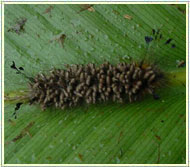Caterpillar Defenses
What do you think of when you see a caterpillar? I bet you don't think of how they defend themselves against their enemies? Yet this turns out to be an important question for both basic ecology and agriculture.
Caterpillars are sometimes cryptic, or camouflaged to blend in with their background. Some that we found today looked like sticks. Others are very brightly colored. The bright colors may help protect the caterpillar from predators because they may advertise that the caterpillar has poisons that might harm the predator. Other caterpillars protect themselves by making leaf shelters. They chew the leaf, fold it over, and use a kind of gluey substance to stick it together. Other caterpillars simply roll the leaf up and hide inside. Some caterpillars try to bite if they are disturbed. Still other caterpillars defend themselves by dropping off the leaf or thrashing around.
 |
 |
 |

Some caterpillars, like this one, try to mislead their enemies about their whereabouts by throwing their frass (poop!) far off.
|
 |
 |
 |
One of our jobs in the field is to poke gently at each caterpillar that we collect to see what it does!
The most obvious natural enemies that you might think of would be birds, rodents, or spiders. Monkeys and insects such as assassin bugs and stinkbugs also eat caterpillars. However, there are other enemies, called parasitoids, which include species of wasps and flies.
These creatures lay their eggs right on or inside the caterpillar's body. The eggs are protected as they develop inside the caterpillar's body. When they hatch, they feed on the tissues of the caterpillar's body.
 |
 |
 |

A close-up of a caterpillar with parasitoids. This is one of several dangers that threaten the caterpillar.
|
 |
 |
 |
How do the caterpillars defend themselves? Some caterpillars feed on plants that produce toxins (poisons) and even store these in their bodies. While this seems to help protect the caterpillars from many predators, the poisons do not affect the parasitoids. In fact, some parasitoids might even prefer toxic caterpillars. Can you think of a reason why?
Top and bottom photos courtesy of Shauneen Giudice/Earthwatch Institute; middle photo courtesy of Dr. Lee Dyer/Earthwatch Institute.

